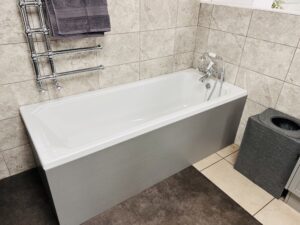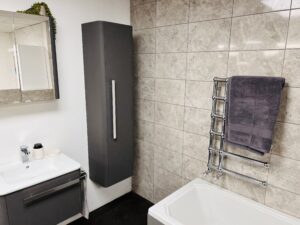
Embarking on a DIY bathroom project can be a rewarding way to upgrade your space while adding personal touches and functionality. Here are some DIY ideas to consider for your bathroom:
1. Painting
Refresh Walls:
- Give your bathroom a fresh new look by painting the walls with a high-quality moisture-resistant paint in a colour that complements your decor style.
Accent Wall:
- Create visual interest and focal point by painting one wall in a bold color or adding a decorative wallpaper pattern.
2. Updating Fixtures
Faucet Replacement:
- Upgrade outdated faucets with modern, water-efficient fixtures to enhance both style and functionality.
Showerhead Upgrade:
- Install a new showerhead with adjustable settings or a rain shower feature for a luxurious bathing experience.
3. Storage Solutions
Floating Shelves:
- Install floating shelves above the toilet or vanity to display decorative items and provide additional storage for toiletries and towels.
Vanity Organization:
- Maximize space inside the vanity by adding drawer organizers, bins, or baskets to keep toiletries and essentials neatly organized.
4. Lighting
Vanity Lighting:
- Replace old lighting fixtures with energy-efficient LED vanity lights or sconces to improve brightness and ambiance in the bathroom.
Accent Lighting:
- Incorporate LED strip lights or recessed lighting under cabinets or along the baseboards to add a soft glow and enhance the overall atmosphere.
5. Tile Work
Backsplash Installation:
- Add visual interest to the bathroom by installing a decorative tile backsplash behind the vanity or bathtub.
Floor Tile Upgrade:
- Replace worn-out floor tiles with new ones in a modern design or opt for a DIY-friendly peel-and-stick tile for easy installation.
6. Mirror Makeover
Framed Mirror:
- Update a plain bathroom mirror by framing it with decorative moulding or trim to add elegance and sophistication.
Medicine Cabinet Refinishing:
- Give an old medicine cabinet a new lease on life by painting it, replacing the hardware, and adding decorative accents.
7. Accessories and Decor
Towel Hooks:
- Install stylish hooks or towel bars on the wall or behind the door to keep towels organized and within reach.
Decorative Accents:
- Add personality to the bathroom with decorative accents such as artwork, plants, scented candles, or decorative jars filled with bath salts or cotton balls.
8. DIY Projects
Custom Vanity:
- Build a custom vanity using reclaimed wood or repurposed furniture for a unique and personalized touch.
Shelving Unit:
- Construct a DIY shelving unit using wood crates, pallets, or plumbing pipes to create storage space for towels, toiletries, and decorative items.





